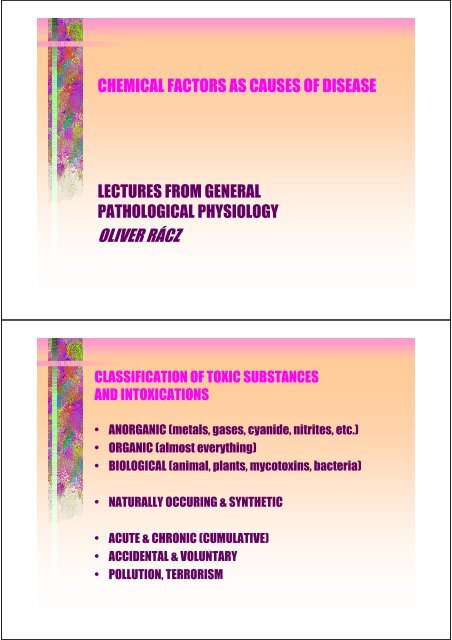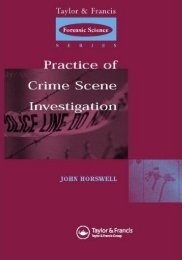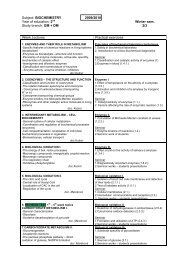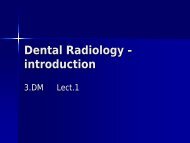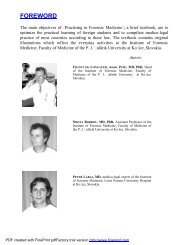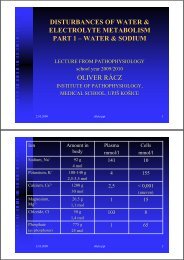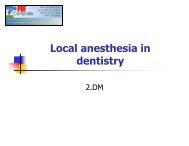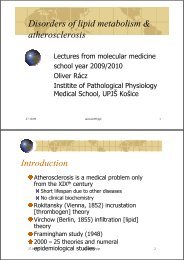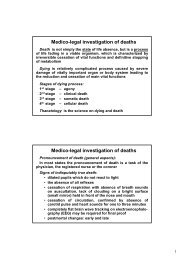OLIVER RÃCZ - TOP Recommended Websites
OLIVER RÃCZ - TOP Recommended Websites
OLIVER RÃCZ - TOP Recommended Websites
Create successful ePaper yourself
Turn your PDF publications into a flip-book with our unique Google optimized e-Paper software.
CHEMICAL FACTORS AS CAUSES OF DISEASE<br />
LECTURES FROM GENERAL<br />
PATHOLOGICAL PHYSIOLOGY<br />
<strong>OLIVER</strong> RÁCZ<br />
CLASSIFICATION OF TOXIC SUBSTANCES<br />
AND INTOXICATIONS<br />
• ANORGANIC (metals, gases, cyanide, nitrites, etc.)<br />
• ORGANIC (almost everything)<br />
• BIOLOGICAL (animal, plants, mycotoxins, bacteria)<br />
• NATURALLY OCCURING & SYNTHETIC<br />
• ACUTE & CHRONIC (CUMULATIVE)<br />
• ACCIDENTAL & VOLUNTARY<br />
• POLLUTION, TERRORISM
Cadmium ( 48 Cd 112 )<br />
• Itai-itai; Japan, 1940 - 1960<br />
– 1 mg Cd/day from rice contaminated by mining waste<br />
– Deficit of vitamin D, Ca, Zn<br />
• Postmenopausal & multiparous women<br />
– Bone deformities, pain in the joints<br />
– Chronic renal disease - hypercalcuria, proteinuria &<br />
glycosuria<br />
(max. permitted 50µg/d; avg ≅ 5 µg; smokers ≅ 10 µg)<br />
Cadmium ( 48 Cd 112 )<br />
• Binding to metallothionein (Cd-Mt)<br />
– 8.5 - 10 kD; rich in Cys; binds 4 - 12 atoms of metalls<br />
• Mechanism of toxicity<br />
– antagonism with Zn<br />
– covalent binding to DNA<br />
– interference with the transport of other Me 2+<br />
– interaction with SH groups<br />
• Nutritional protection<br />
– Zinc
Mercury ( 80 Hg 201 )<br />
• WIDESPREAD USE IN A VARIETY OF PRODUCTS<br />
❊ 5-6*10 6 kg released to the environment every year<br />
❊ accumulation in marine sediment → fish<br />
• HIGHLY TOXIC COMPOUND (lipohilic, volatile)<br />
• Hg 0 vapors - inhalation, lung damage<br />
• Hg salts (sublimate, HgCl 2 - GIT, kidney damage<br />
• Hg in medicine (syfilis, calomel, dermatology,)<br />
• MethylHg - CNS, teratogen<br />
• amalgames used in dentistry ?<br />
❊ Affinity for SH groups & Fenton reaction catalyst → oxidative<br />
stress<br />
❊ inactivation of enzymes, membrane & transport system damage<br />
etc.<br />
Mercury ( 80 Hg 201 )<br />
• MINAMATA BAY, JAPAN<br />
Metallic Hg released from a factory into the sea<br />
transformed to organic mercury compounds.<br />
Consumption of contaminated fish and shellfish →<br />
staggering cats, CNS injury & deaths in fishermen, birth<br />
defects in newborns<br />
• IRAQ, 3 epidemics (50‘s - 70‘s)<br />
Bread made from grain treated with organomercurial<br />
antifungal agents
Lead ( 82 Pb 207 )<br />
• Used throughout modern history of mankind<br />
• XXth Century - gasoline additive<br />
• Current production - 3.8*10 6 tons/year<br />
contribution to history<br />
❋ Nero‘s madness (wine in pewter vases)<br />
❋ The fall of Roman Empire (lead water pipes*)<br />
❋ „Franklin“ expedition to the Northwest Passage, 1845 (lead<br />
seals of tin cans)<br />
❋ Vincent van Gogh‘s illness & madness (paints)<br />
*EPA & WHO standard < 0.05 mg/l<br />
YEAR Pb, µg/m 3<br />
1970 0.91<br />
1978 0.84<br />
1982 0.32<br />
Lead - toxicity<br />
• Lethal dose ≅ 0.5 g<br />
• Harmful > 10 µg/l blood<br />
• accumulation in bones,<br />
replaces Ca<br />
• t 1/2 ≅ 15 - 20 years<br />
• children more sensitive<br />
• organic compounds are<br />
more dangerous<br />
DAMAGE OF<br />
• Brain and nerves<br />
• Liver<br />
• Kidney<br />
• Blood<br />
– synthesis of porphyrins<br />
• Reproductive system<br />
• Digestive system<br />
• Immune system
Cyanide and related compounds<br />
• HCN, KCN - electron transport in mitochondria<br />
(Cytochrome A)<br />
• Increase in respiration, paralysis of all cells (BP fall,<br />
convulsions, coma)<br />
• Sources<br />
– Industry<br />
– Cassava & manioca roots (glycosides)<br />
– stones of bitter almonds, apricots (glycosides)
*and heavy metals!<br />
Baia Mare (RO), 30 th January 2000<br />
Gold reprocessing facility,<br />
leak of a tailing pond <br />
378 500 liters toxic<br />
sludge (8g KCN /l)*<br />
River Lapus Somes <br />
Tisza (February 3, 12 mg/l;<br />
590 km of very sensitive<br />
ecosystem)<br />
Danube (end of February<br />
till higher than 0.1 mg/l )<br />
• More than 100 tons of dead fish,<br />
some of them rare and<br />
endangered species.<br />
• Other water animals killed too -<br />
frogs, crabs, insects, etc.<br />
• Secondary intoxication &<br />
perishing of otters, beavers,<br />
birds, dogs<br />
• Cyanides are unstable<br />
• Danger of ecological<br />
catastrophe<br />
• Monitoring & prevention in the<br />
future<br />
Purvis A.: Deadly Discharge. Time 155, 2000, No 6; February 28, p.26<br />
Bombová E., Kupcová M.: V zápase s kyanidom v riekach život azda celkom neprehrá. SME 22.2.2000<br />
Further examples<br />
• Contergan, thalidomid, 1957 - 1961<br />
– 2625 cases of birth defects (phocomelia)<br />
• Seveso, Italy, 1976 (& in Vietnam war)<br />
– DIOXIN ➡ SKIN, LIVER, BRAIN (CUMULATIVE)<br />
• Bhopal, India, 1984, Union Carbide<br />
– CH 3 -N=C=O (methyl isocyanate)<br />
– 7000 residents died within days, 500 000 affected,<br />
many survivors remain ill or disabled after 15 years<br />
• Asbestos - Lung Ca, bankruptcy of Lloyd‘s
CHERNOBYL, 1986<br />
6 tons of radioactive fuel released = 10 EBq* in two<br />
phases (during the explosion and a week later)<br />
143 cases of acute radiation illness, 28 ✟<br />
(unsuccessful attempts of bone marrow transplantation)<br />
Radioactive fallout and exposition:<br />
600 000 person*sievert<br />
40 % Soviet Union; 50 % Europe<br />
Exa = 10 18
CHERNOBYL 1986 - RELEASE OF SOME<br />
RADIONUCLIDES<br />
NUCLIDE HALF-LIFE ACTIVITY, PBq RELEASE<br />
Xenon 133 5.3 d 6500 6500<br />
Iodine 131 8 d 3200 1760<br />
Cesium 134 2 y 180 54<br />
Cesium 137 30 y 280 85<br />
Tellurium 132 78 h 2700 1150<br />
THYROID CANCER IN CHILDREN BEFORE AND<br />
AFTER CHERNOBYL<br />
AREA 1981-1985 1986-1994<br />
GOMEL 1 164<br />
BELARUS 3 333<br />
NORTHERN<br />
1 118<br />
UKRAINE<br />
UKRAINE 25 209<br />
PREVENTION BY KI DELIBERATELY NEGLECTED
POPULATION DOSE, mSv + DEATHS<br />
200 000<br />
emergency workers<br />
135 000<br />
evacuees (30 km)<br />
270 000<br />
control zone residents<br />
6 800 000<br />
whole area residents<br />
100 2200<br />
10 160<br />
50 1600<br />
7 5000<br />
GREECE: 2.6* Increase of leukemia in children ?!<br />
MAYAK RIVER, PLUTONIUM PLANT<br />
1949 - 1956; 65*10 6 m 3 radioactive waste<br />
1700 times the permitted exposition<br />
28 000 affected people in 28 villages<br />
The effects of alcohol<br />
• Acute alcohol intoxication (Noe)<br />
• Alcoholism (addiction)<br />
– Alcoholic is who drinks more than his doctor<br />
• Withdrawal syndrome (delirium, white mice)<br />
• Diseases associated to alcohol consumption<br />
• Beneficial health effects of moderate drinking<br />
– The French paradox
Alcohol and the western populations<br />
• Absolute abstainers 10 %<br />
• Consistent consumers 20 %<br />
• Nonconsistent consumers 20 %<br />
• Occasional heavy drinkers 27 %<br />
• Regular heavy drinkers 20 %<br />
• Addictive alcoholics 3 %<br />
Alcohol and diseases<br />
• Direct effect (brain, liver)<br />
• Energy content (beer ⇒ obesity)<br />
• Deficient nutrition (B vitamins ⇒neuropathy)<br />
• Toxic compounds (Methanol, Glycols, Cobalt, Thujone<br />
from absynth<br />
♥ The French paradox (CHD in France vs Scotland<br />
♥ ⇑ HDL cholesterol, ⇑ fibrinolysis, ⇓coagulation,<br />
⇑insulin sensitivity<br />
♥ Decreased risk of MI<br />
♥ Antioxidants ? Life style ?


